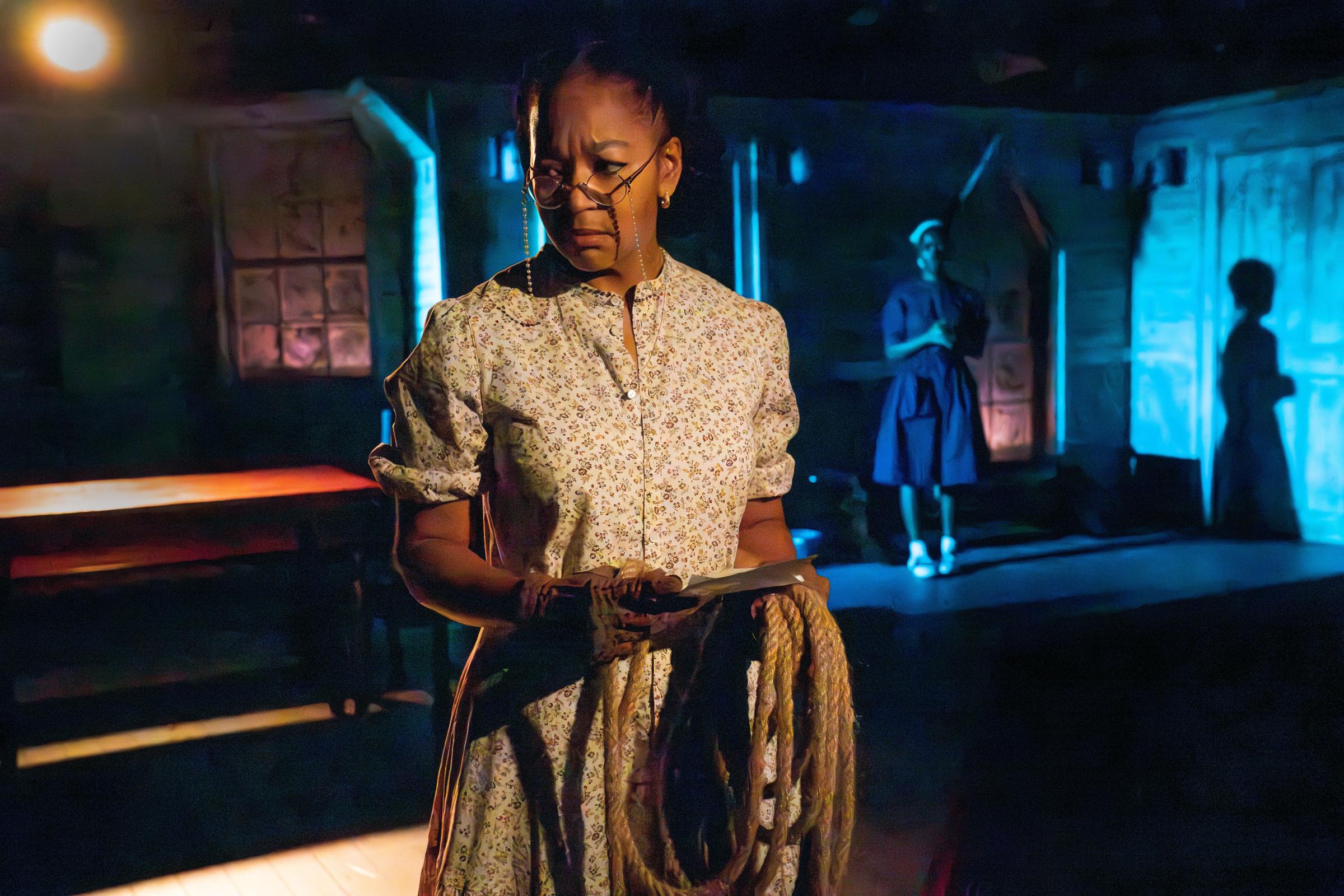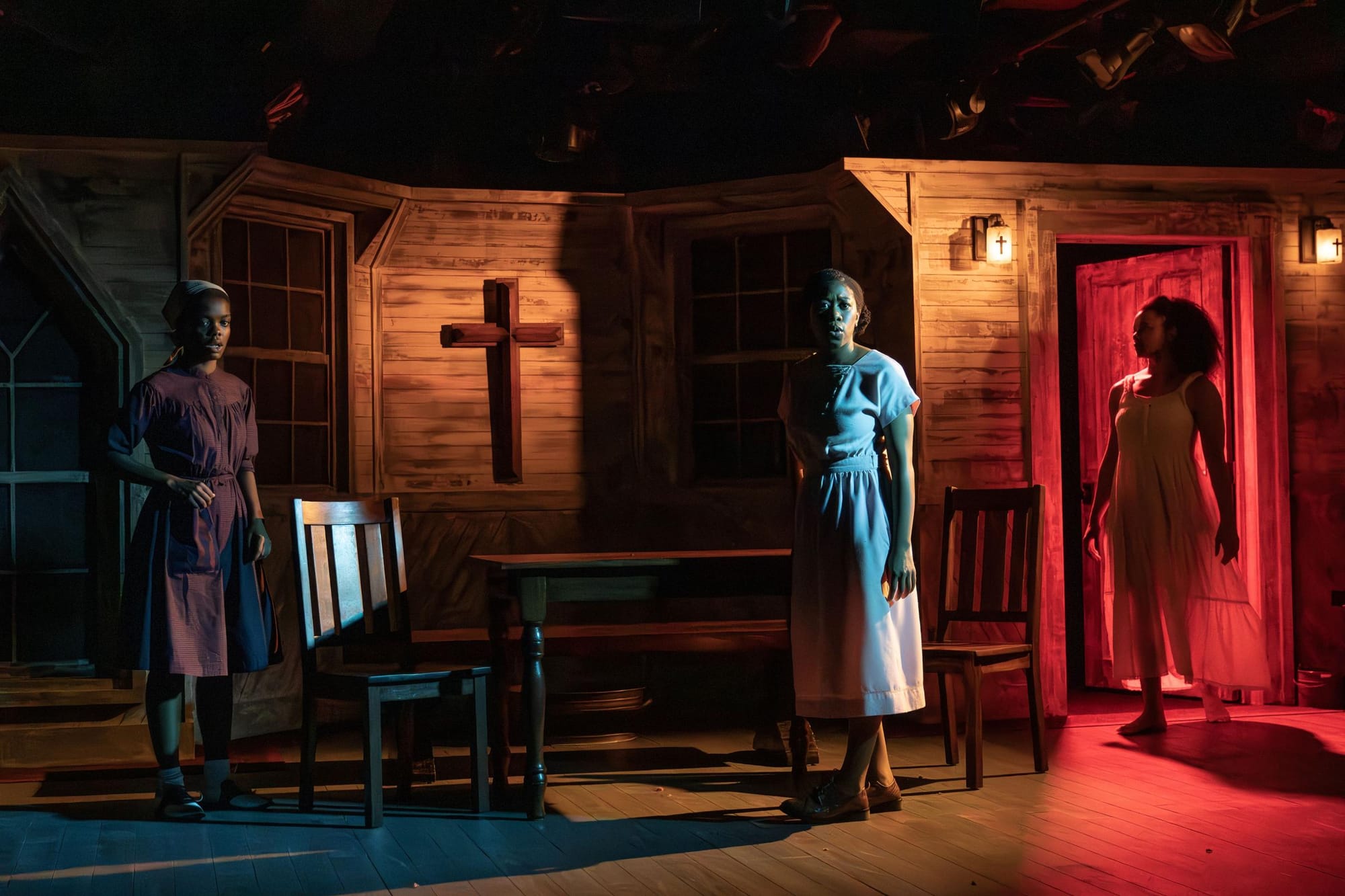Covenant
Roundabout Theatre Company
111 W. 46th St
New York City
Through Dec. 17
Halloween might be over, but squeals of terror and delight still fill the air of New York’s theaters, especially Roundabout Theatre Company’s underground black box, where Covenant runs through December.
The production, a world-premiere and New York debut for playwright York Walker and Roundabout debut for director Tiffany Nichole Greene, horrifies, transfixes, and most excitingly, rewards those who are sharp watchers and keen listeners. In a 1936 Georgia small town where rumors, secrets, and shame darken the lives of its characters, the light of truth often lies in small details — but then again, so does The Devil.
According to the play’s official synopsis, “when a struggling guitarist (Johnny “Honeycomb” James, played by Chaundre Hall-Broomfield) returns to his small Georgia town a blues star, rumors begin swirling that he may have made a deal with the devil to attain his musical genius. Before long, however, it becomes clear he’s not the only one with a secret.” Johnny’s return to his hometown rips open old wounds, creates new ones, and forces everyone to decide whether unholy means justify righteous ends.
Even though all of the action of Covenant takes place after Johnny’s arrival, much hinges on the resurfacing of characters’ unsettling memories and pasts. Walker cleverly introduces this lore through an ominous spin on the old rumor mill. Each character has a direct-address monologue that sits somewhere between church gossip and fireside scary story, wherein they describe a bone-chilling event that they “one heard” happened to some unnamed subject of each story. But, tracking the small details in these “rumors” (ex. “name as sweet as a flower”) reveals that they hit much closer to home than each speaker lets on.
The same holds true for much of Walker’s dialogue, which regularly employs what I like to call Southern wordsmithing — all of the resourceful language and turns of phrase that provide an indirect path to a sentiment that, when spoken directly, might turn heads in a house of God. These phrases, like venom dipped in honey, tend to require an extra moment for their true weight to be felt, and Greene’s direction provides exactly that when it is needed, without letting the play lose its momentum. Greene also ensures that the comedic moments in the earlier parts of the play land true, so that the eventual plunge into the abyss feels all the more precipitous.
One reason I love horror plays is that they tend to allow more bold, pronounced choices from their design teams, which is certainly the case here. The audience is split between two sides of the aisle of Lawrence Moten III’s set, which surrounds on all sides and doubles as a wood-paneled church and home. The production has its own illusionist, Steve Cuiffo, who renders the devil’s magic onstage and has characters and objects appearing in all kinds of unexpected places.
Lighting and sound design, by Cha See and Justin Ellington respectively, offer a sizable helping of complete, sudden blackouts and sharp musical stings that even had this regular theatergoer ready to jump out of his seat. And even here, looking and listening closely pays dividends; small details in the lighting and sound design foreshadow, perhaps more brazenly than the text itself can, the devilish dealings that go on behind the scenes.
The production is also held down by an excellent cast of performers who excel at keeping secrets and telling lies with just the right amount of conviction. Among them are Crystal Dickinson, who plays Mama, mother to Avery and Violet, and Lark White, who plays Ruthie, a close family friend. Dickinson keeps a compelling iron grip on Mama’s all-consuming desire to deliver Avery and her faith from the evils present in the play, while White’s nervous energy and earnest desperation make up a beautifully layered performance that doesn’t truly peel all the way back until the final moments of the play.

With a close-quarters dramatic horror experience like Covenant, audience engagement begins long before the final applause. If you like a muted, still, boring audience, this might not be the one for you. Amusing shrieks, laughter, jumping, pointing, and “Oh hell no!”s from the audience are so integral to the Covenant experience that Roundabout has even started incorporating it into the marketing for the show.
I was fortunate to attend Covenant on Black Queer Theatre Night, one of the multiple community nights Roundabout hosts throughout the season, planned in collaboration with artists to ensure their work finds the intended audience.” My particular audience experience was a hoot and a holler and then some, likely given a communal affinity for call and response to performance, and a longstanding history of Queer themes in horror. Furthermore, I believe that there’s an enhanced appreciation for the Southern wordsmithing Walker uses throughout the show, which I believe shares at least some linguistic connective tissue with our coveted shade.
After the performance, Roundabout hosted a Black Queer Theatre Night reception, which included a meet & greet with the cast and director, catering by Home Sweet Harlem, and a welcoming space for community, fellowship, and enthusiastic unpacking all that we had just witnessed. The uptick in community affinity theater performances like these is one of my favorite industry trends of the last few years, and I hope they continue.
Covenant is a blast, but it’s definitely not for the faint of heart. I highly recommend bringing a friend you can hold on to, and point out all the juicy little details with.
Still Playing: Covenant is running until Dec. 17t. As of writing, the run is mostly sold out, but their standby ticket policy is available here.
Up Next For Me: I’ll be co-reviewing Barkley L. Hendricks: Portraits at the Frick Madison Collection with fellow Review Crew contributor Betsy Kim!






